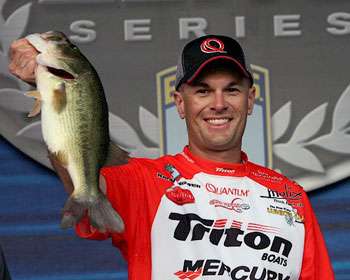
During the dog days of summer, if a bass angler goes out and catches three or four nice bass, it's a good day on the pond. In the fall, however, the catch ratio goes way up.
Elite Series pro Randy Howell pegs fall as one of his favorite seasons for bass fishing, particularly if he's on the water with some wind at his back. On a calm day in late fall, establishing a cohesive pattern can be one of the toughest things to do.
Enter a little wind, however, and things can ripen quickly. "The old saying, 'Let the wind be your friend' is always important, but even more so in the fall," he says. "A perfect recipe for a tough day in the late fall is to have slick water conditions. If you take that same lake and throw a 10- to 15-mile-per-hour wind in the mix, it will stir the water column and make the fish more active." With a good breeze, Howell points out that baitfish get pushed into shallow bays or points, creating a buffet-style feeding opportunity for opportunistic bass.
"I look for muddy or transition colors because the shad will usually be up there in that stained water," he says. "Using the wind to your advantage is really the best pattern you can develop because it's going to be applicable anywhere around the lake." Fishing the wind during the fall requires a steady set of sea legs, and as Howell points out, a gunslinger's arm for all the "chunking and winding" that will be required.
"I love to throw crankbaits along windblown points in the fall," he reveals. "On a lot of the Alabama and Coosa River lakes, a shallow diving crankbait is pretty tough to beat." Howell prefers a crankbait that dives in the 2- to 5-foot range because that is where most of the shad will be suspended.
Once a prime area has been located, the key becomes making as many casts as possible. On clearer lakes, such as Alabama's Lake Guntersville, Howell points out that a deeper-diving crankbait can be employed. "If I can get out away from the grassline on a deeper windblown point, I really like to use a Strike King Series 5 or original Bomber Fat Free Shad," he says. "I've seen Guntersville during the fall where you couldn't buy a strike up shallow. But with a little wind, the offshore bite can just load the boat."
Using a strong fall wind as the key factor, Howell explains that an angler can run the table by finding similar windswept areas lake wide. "During the fall, wind instantly gives me confidence," he admits. "If you can read the water and how it's moving with the wind, you immediately know where the bass are gorging themselves on bait along those windswept points and banks."
Conversely, Howell explains that those same bait-frenzied bass from windy days are a lot less active on fall days without wind. "You can go back into those same areas and see fish on your graph, and maybe even see a few fish occasionally break the surface," he says. "Without any wind to bunch the bait up, though, they're just so scattered that it's almost impossible to have much success."
By following the direction of the wind and fishing main lake points and shallow pockets, Howell points out that an angler is almost able to call his shots in the fall. "You can go into the back of a shallow pocket that has wind coming in and pick up a 1/4-ounce Rat-L-Trap and just wear them out," he says. "You can literally put the boat in the middle of the pocket and just fan cast all around the shallows."




